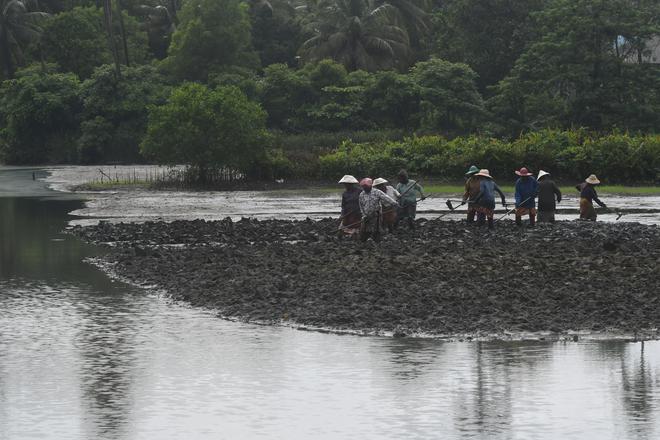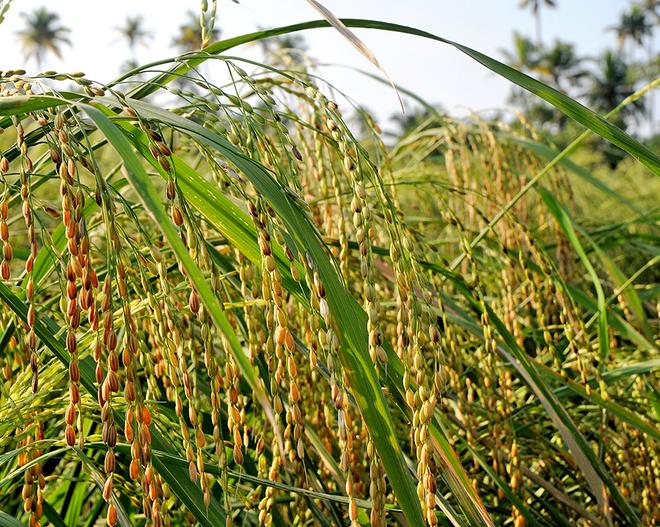A drive along the thin black ribbon-like road flanked by paddy fields in Ezhupunna village in Cherthala taluk can be a captivating sight for a visitor.
On one side are partially submerged fields with paddy seedlings spearing through the water surface here and there while the other showcases a network of fields under water. For a pokkali farmer, that sight tells the tale of continuing neglect.
Normally, the fields should have sported an identical look by this time of the year — well ploughed and separated into furrows and mounds, bunds bordering them, water properly regulated, and seeds sprouting rather uniformly. The situation on ground, however, presents a different story.
Theoretically, at least, pokkali, the saline water-resistant, nutritious and premium-priced rice, should have been everyone’s darling with Geographical Indication Certificate and Genome Community Award thrown in for good measure. But in practice, the acreage under pokkali farming done across Ernakulam, Thrissur, and Alappuzha districts has dropped from 25,000 ha to about 5,000 ha at the turn of the century. That said, actual farming takes place in less than 1,000 ha.
Pokkali farms are supposed to adhere to a double crop calendar — paddy between April and October during the low saline phase of monsoon and saline aquaculture between November and March when salinity soars.
“If rice is to be included in the rice-prawn integrated farming system of pokkali region, then the fish culture must end by April 15 for preparing the land for a successful pokkali rice crop. A thorough and sufficiently long land preparation is necessary to reduce soil salinity from about 24 deciseimens per metre (ds/m) to the desirable level of less than 4 ds/m,” says N.K. Sashidharan, former associate professor of Agronomy at Kerala Agriculture University (KAU), who has several research projects on rice production in pokkali fields to his credit.

Land preparation involves dewatering and drying the land which help neutralise the chemicals used during saline aquaculture. It is then ploughed and separated into furrows and mounds as evaporation of moisture leaves behind sodium chloride crystals to be blown away by the wind while the pre-monsoon showers further wash away salinity. Then once the monsoon sets in and stabilises, the germinated pokkali paddy seeds are sown on the mounds and furrows.
But this elaborate preparation period, critical to a successful yield, is often observed in breach as dewatering, which is supposed to be complete by April 15, is delayed in violation of the crop calendar ostensibly to help aquafarming.
“This year, the saline aquaculture lobby also managed to get the period of the aquaculture crop extended till April 30 citing the pandemic. But they could well have harvested their crop even if dewatering was to get under way as scheduled. Those in charge of paddy polders are responsible for dewatering the fields, for which the government provides equipment and free electricity. However, they often fail to do this which adversely affects the preparation of the fields in line with the crop calendar notified by the Pokkali Land Development Authority and the practices prescribed by KAU,“ says Francis Kalathungal, general convener, Pokkali Samrakshana Samiti (PSS).
This is strange given how paddy cultivation and saline aquaculture are interrelated. The decaying stalks left behind after pokkali harvesting serve as a natural organic feed for saline aquaculture that follows. And the outer skin shed by shrimps during their developing stage gets deposited on the field floor, enriching the soil for the next round of paddy cropping. This eliminates the need for fertilizers or pesticides.
Chandu Manjadiparambil, 77, a pokkali farmer from Maravakkadu in Chellanam, argues that the scales have now tilted in favour of aquaculture. His return this time was just 40 kg of rice from 2.25 acre.
“I had harvested 1,800 kg of paddy even at the height of the 2018 deluge. But this time, aquaculture operators submerged my fields ahead of the harvesting season . Unless the aquaculture operators are made to comply with the crop calendar, there is no future for pokkali farming. Also, dewatering should be entrusted with a government agency rather than the paddy polder committee,” he says.

Maravakkad, once considered the heartland of pokkali rice in Chellanam with cultivable fields spread over 261 acres, has not witnessed farming in more than 10 acres in the past decade. Ironically, it has emerged as a flashpoint between the proponents of pokkali farming and aquaculture leading to five cases in the High Court.
Mr. Manjadiparambil, one of the litigants, was scathing of the paddy polder, Maravakkad Padashekhara Karshaka Union (MPKU), accusing it of furthering the interests of aquaculture operators.
The accusation was, however, shot down by the MPKU, its secretary K.J. Jacob attributing the disruption in farming to natural causes, including sea erosion. But 98-year-old Philomena Baby Joseph in South Chellanam shows how pokkali has survived the vagaries of nature over time. She has been farming in 10 acres at Maravakkad for over half a century now.
The High Court disposed of all petitions in October last year and appointed a monitoring commission headed by an advocate commissioner to oversee the pokkali-fish integrated farming in the Maravakkad polder for the next two years.
“After more than a decade, pokkali is being cultivated in nearly 130 acres in Maravakkad and over 100 farmers are participating thanks to the interest shown by the High Court. This is a starting point and things will only get better,” says Renil Anto Kandamkulathy, advocate commissioner-chairman of the Kerala High Court-appointed monitoring committee.
The government has a policy to preserve both pokkali and aquaculture as reflected in its policy of ‘one crop of rice, one crop of fish’. But many recommendations made by an expert committee on sustainable aquaculture in pokkali and kole lands in 2013 remain on paper.
“We had unequivocally made it clear that pokkali farming should continue and that the crop calendar should not be tinkered with. Unfortunately, since then the condition of pokkali farmers has only worsened,” says B. Madhusoodana Kurup, former Vice Chancellor of the Kerala University of Fisheries and Ocean Studies, who chaired the committee.
The committee had recommended that the government conserve the available pokkali fields and maintain them as heritage farming villages and find them a place on the global list of heritage villages. It also said that licence for shrimp farming should only be given in those fields raising one crop of paddy. Ironically, pokkali farming has become a ruse to secure fish farming licence.
While a senior Fisheries department official insisted that the licensing norm has been adhered to and exemption is granted only in cases where the Principal Agriculture Officer concerned has certified that no paddy cultivation is possible, the Agriculture department denies such a practice. A major bone of contention is over finalising contracts for aquaculture well before the pokkali season gets over.
K.G. Padmakumar, Director of International Research and Training Centre for Below Sea Level Farming and former special officer for pokkali farming, observes that the potential for other productive activities should be explored alongside pokkali farming since rice alone cannot offset the cost of farmers.
“Climate change has also taken its toll on pokkali farming with the monsoons turning erratic, disrupting the preparation of the fields. Pokkali is also critical for Kerala from an ecological perspective as pokkali farms, if they manage to turn into freshwater repositories for six months a year, can be a formidable defence against saline water intrusion and, hence, must be preserved irrespective of the costs involved,” he says.
Studies by the KAU have proved that pokkali fields are excellent aquifers that can store about three lakh litres of water. This annual recharging of groundwater sources helps withstand the massive pressure of salinity.
On the other hand, turning pokkali fields into saline water repositories for aquaculture for prolonged periods could cause augmented deterioration of cement structures in their vicinity as experienced by T.J. Xavier, who lives in the middle of pokkali farms in Chellanam.
“A part of my house collapsed last year after farms were made to hold saline water round the year for aquaculture. It is common practice for aquaculture operators to release fish seedlings into fields even before the paddy season is over,” he says.
Antony Joemon, an aquaculture contractor who had taken the fields on lease for shrimp farming at Maravakkadu, however, bemoans how the returns never matched up to the investment of over ₹2 crore last year. But he was evasive when asked why he kept investing if that were the case.
V. Sreekumar, former head of the Vytilla-based Rice Research Station (RRS) under the KAU, feels that owing to better returns there is an urge to extend shrimp farming disrupting the crop calendar, reducing pokkali farming to a token activity.
“Paddy fields at Andhakaranazhi in Alappuzha bear testimony to how persistent salinity could make the soil unfit for farming. The cultivation of vegetables and other produces in the homesteads has also been hit. An exclusive special package for the socioeconomic development of the entire pokkali tract is needed,” he says.
Lack of mechanisation has added to the woes of farmers. Though a prototype of a floating harvester, which received patent later, was developed by the KAU in 2013, its trial run in Ezhupunna did not work out.
“It got submerged in the soggy fields owing to its large size and weight. They are now modifying this model to develop a scaled down prototype at the Kelappaji College of Agricultural Engineering and Technology, Tavanur, under the All India Coordinated Research Project on farm machinery funded by the Indian Council of Agriculture Research,” says P. Rajendran, former Vice Chancellor, KAU.
While low productivity — pokkali yield per hectare is about 2.50 tonnes compared to 7-8 tonnes a hectare from other variants — and low profitability are being cited as among the reasons for the drop in pokkali farming, the Pokkali Samrakshana Samiti cites an audit report showing how pokkali farming in 264 acres at Ezhupunna in 2014 gave it a profit in excess of ₹8 lakh.
Though largely perceived as sticklers for tradition, at least a section of pokkali farmers seems to have turned to the high-yielding seed varieties developed by the RRS. This has been noticed reportedly since the 2018 floods, when the yield from the traditional varieties tanked with the success stories of RRS varieties adding impetus.
“We have developed 11 varieties, which are high yielding and tolerant to acidity, salinity, and submergence. Our latest pokkali varieties are shorter, less vulnerable to lodging and, hence, yield more,” says Deepa Thomas, Assistant Professor, Agronomy, RRS.
While pokkali is accused of being labour-intensive making it costlier, Mr. Manjadiparambil comes up with a back of the envelope estimate to rubbish the argument. Also counting labour cost, the cost of pokkali farming in one acre is roughly about ₹61,000 while the returns stand at ₹1.2 lakh, including the price of rice and subsidies.
To his credit, he has proved over the past 22 years that, given a level-playing field, pokkali is indeed economically viable.
Despite the challenges, farmers such as Ms. Baby Joseph, perhaps one of the oldest pokkali proponents around, refuse to give up as it is something so close to their lives, having grown it for long. But each passing season makes her wait for the next. “That’s how it’s going to be until my death,” she says.







